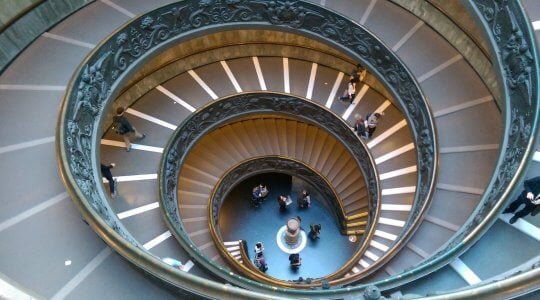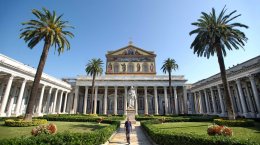Official Reseller Rome and Vatican – Jubilee 2025
Vatican Museums
Within the Vatican City State in Rome, to be precise in Viale Vaticano, is located one of the largest museum complexes in the world: we are talking about the Vatican Museums, 7 km of exhibition itinerary that preserve the immense patrimony of works of art collected by the Popes over the centuries.





Within the Vatican City State in Rome, to be precise in Viale Vaticano, is located one of the largest museum complexes in the world: we are talking about the Vatican Museums. They extend over a large part of the large Belvedere courtyard and represent one of the most prestigious artistic containers in the world, given that they preserve the immense patrimony of works of art collected, over the centuries, by the Popes. Great masterpieces can be admired in the 7 km of exhibition itinerary of the Museums: among them the famous Sistine Chapel and the papal residences frescoed by Michelangelo and Raphael.
Background
Founded by Pope Julius II in 1506, the Vatican Museums opened their doors to the public in 1771, at the request of Pope Clement XIV. The museum complex originally appeared as a collection of classical sculpture. The popes, in fact, considered themselves the legitimate heirs of Roman history and civilization and for this reason the monuments had to be preserved in full respect of their value. In 1506, the Cortile delle Statue, which is the current Octagonal Courtyard, hosted the first nucleus of classical works of the Vatican Museums: it was an exemplary collection of ancient sculptures, set up for Julius II and including statues such as the Apollo del Belvedere and the Laocoonte Group. In the second half of the 18th century, the popes Clemente XIV and Pio VI furthered the decision to create a museum with an articulated structure. Therefore, the collection of classical antiquities underwent a transformation, but the Courtyard was however included in the new museum plan, becoming its fulcrum. The fifty years between Enlightenment, Revolution, Empire and Restoration were particularly decisive: by virtue of the discovery of a large number of findings (thanks to excavations carried out throughout the Lazio region) and the numerous acquisitions carried out at antique dealers or collectors, the pontifical collections grew considerably.
Over the following centuries, the Vatican Museums continued to expand, until they reached the present form of their exhibition itinerary: 13 museums in a large complex consisting of two Vatican palaces.
Vatican Museums: rooms and collections
The Museums
Every year, millions of visitors crowd the halls and corridors of the Museums, contemplating the majestic beautiful works. Among the museums and collections of the complex, we find first, the Vatican Pinacoteca. Initially located in the Borgia Apartment, the latter was later transferred to a building dedicated to it, by order of Pius XI.
This museum contains masterpieces by painters such as Giotto, Leonardo, Michelangelo and Caravaggio. The modern religious art collection is of great value, which includes works by famous artists such as Salvador Dalì, Francis Bacon, Marc Chagall, Giorgio De Chirico, Paul Gauguin, Henri Matisse and Vincent Van Gogh. The building continues with the Pio Clementino Museum, founded by Clement XIV in 1771 and then enlarged by Pius VI.
Originally, it housed a collection of ancient and Renaissance works, today the museum houses, instead, mainly Greek and Roman sculptures. Other masterpieces of religious art, of various origins, can be admired in the Missionary-Ethnological Museum, whose foundation, by Pius XI, dates back to 1926. For lovers of ancient Egypt, a visit to the Egyptian Gregorian Museum is a must: its vast collection includes papyrus, mummies, the famous Book of the Dead and the Grassi Collection. Etruscan findings, on the other hand, can be observed in the 8 galleries of the Gregorian Etruscan Museum, founded in 1836 by Gregorio XVI.
The exhibited material consists of vases, sarcophagi, bronzes and also includes the famous Guglielmi Collection. Of great historical importance is the Chiaramonti Museum, which takes its name from its founder, namely Pope Pius VII Chiaramonti. It consists of an extensive arched gallery, at whose sides we find sculptures, sarcophagi and friezes. The new wing, the Braccio Nuovo, boasts the presence of famous statues such as the Augusto di Prima Porta. The Chiaramonti Museum also includes the Lapidary Gallery, which contains the world’s largest collection of stone inscriptions and tablets (there are more than 3000 of them). However, it is open to the public only for study purposes.
The Vatican Palaces: the galleries
In the rooms that can be visited of the Vatican Palaces, we meet other singular galleries such as the Gallery of the Candelabra, the Galleria degli Arazzi and the Gallery of Maps. In the case of the latter, one cannot but be impressed by the extraordinary cartographic representation of the Italian regions, built between 1581 and 1583: on the walls of the gallery there are 40 maps of the different regions of Italy, each with the maps of the important cities and with the representation, on the ceiling, of the main religious events that took place in each region.
Chapels and rooms
There are some chapels that you can visit, such as the Niccolina Chapel, the Chapel of Urban VIII and, dulcis in fundo, the Sistine Chapel. Built between 1475 and 1481, it owes its name to Pope Sixtus IV. Its fame is worldwide for two reasons: firstly, it is the seat of the conclave and other official papal ceremonies; secondly, the vault and the back wall, above the altar, are decorated with frescoes by Michelangelo Buonarroti, which makes it one of the most famous and celebrated masterpieces of the western art world. The tour also includes some rooms such as the Sala della Biga, the Sala Sobieski, the Sala dell’Immacolata, the Stanze di Raffaello, the Loggia di Raffaello.
Useful tips for visiting the Vatican Museums
The Vatican Museums are easily accessible from Ottaviano and Cipro metro stations (Line A, direction Battistini). On top of the complete tour of the museum complex, you can add a visit to St. Peter’s Basilica and the Vatican Gardens, the latter rich in artistic jewels, fountains and water games. Furthermore, walking along Via della Conciliazione and a short stretch of the Tiber, it is possible to reach the imposing Castel Sant’Angelo and then, from there, crossing the Tiber, the Palazzo-Oratorio dei Filippini.
Monday to Saturday 09:00 a.m. – 6:00 p.m. (final entry 4.00 p.m.)
Every last Sunday of the month (on the condition that this does not coincide with Easter Sunday, June 29, Saints Peter and Paul, December 25 Christmas Day and December 26 Saint Stephen’s Day) 09:00 a.m. – 2:00 p.m. (last entry 12.30 p.m.) Free entry
2018 closures
Sunday (except the last Sunday of each month), January 1 and 6, March 19, April 2, May 1, June 29, August 14 and 15, November 1, December 8, 25 and 26
Visitors are required to leave the halls 30 minutes before the museum closes
For more information http://www.museivaticani.va/content/dam/museivaticani/pdf/utilities/calendario_musei.pdf
Check the stops of the Open Top Bus Vatican & Rome on the map in order to find the closest stop to the attraction you are interested in visiting;
Alternatively, consult https://www.google.com/maps for information on public transport.
Remember: with Omnia 72h you have access to all means of public transport of Rome.
Sistine Chapel, St. Peter’s Basilica





